Looking to flip NFTs for real profits in 2025? This in-depth guide reveals the most profitable NFT flipping strategies used by smart traders to identify undervalued projects, time the market, and maximize ROI. Learn how to spot NFT collections with long-term value, leverage advanced tools like Nansen and NFTGo, and use DeFi integrations, cross-chain opportunities, and community intelligence to your advantage. Whether you're a beginner or a seasoned investor, discover actionable tips, market trends, risk management tactics, and real-world success stories to help you build a winning flipping strategy in today’s dynamic NFT landscape.
Why You Should Keep an Eye on “Mythic Piece” – A New NFT Experience Like No Other:
The NFT space is constantly evolving, but few projects truly break the mold. “Mythic Piece” is one of those rare gems – a project shrouded in mystery, yet undeniably intriguing. While many NFT collections simply offer digital assets, “Mythic Piece” hints at something far more immersive and dynamic.
This is not just another collection; it's the beginning of an adventure. The project is designed to unveil its secrets over time, rewarding those who engage early and follow its development. If you have an eye for innovation in the NFT world, this is something you won’t want to miss.
To get a first glimpse of the journey ahead, watch the official launch video: “Awaken! Rise! – The Mythic Pieces Call... Will You Answer?!”
This short yet powerful teaser sets the tone for what’s to come: an experience that promises to go beyond the ordinary.
For now, details remain scarce, adding to the project's allure. But what we do know is that “Mythic Piece” is set to offer an experience unlike anything seen before in the NFT space. With its unique vision this could be one of the most exciting projects to emerge.
The best way to stay ahead? Follow “👑 Mythic Piece 🔱” on:
- X.com: https://x.com/mythicpiece
YouTube: https://www.youtube.com/@MythicPiece
TikTok: https://www.tiktok.com/@mythic_piece
And if you want to secure a place in this unfolding journey, now’s your chance – the Whitelist is still open, offering lucky participants a chance for free minting.
The adventure is only just beginning. Will you be part of it?
Table of Contents:
- What Is NFT Flipping and Why It’s Still Profitable in 2025:
- NFT Market Trends in 2025 Every Trader Should Know:
- Key Factors That Influence NFT Flipping Profits:
- Risks and Challenges in NFT Flipping Today:
- Most Profitable NFT Flipping Strategies for 2025:
- Focus on NFTs with Real Utility and Long-Term Value:
- Flip Fractionalized NFTs and Tokenized Real-World Assets:
- Use DeFi Tools to Boost NFT Flip Returns:
- Exploit Cross-Chain Arbitrage Opportunities:
- Leverage AI and Analytics for Better Flip Timing:
- Quick Strategy Recap:
- Final Thoughts from a Flipper in the Field:
- Essential Tools and Tips for Smarter NFT Flipping:
- Real‑World NFT Flipping Success Stories:
- CryptoPunks – Blue‑Chip Resurgence and Million-Dollar Flips:
- Gaming NFT Flip – Axie Infinity Breeding Strategy:
- DeFi-NFT Success – Yield + Flip Combo:
- Fractionalized NFT Flips – Tokenized Art in Action:
- What Elite Flippers Do Differently in 2025:
- Personal Field Note from My Flips:
- Top Lessons from These Success Stories:
- What’s Next? Emerging NFT Flipping Opportunities:
- AI-Generated & Smart NFTs (iNFTs) – The Future Is Evolving:
- Metaverse Land & Virtual Asset Flips – Digital Real Estate Is Heating Up:
- Brand-Backed Utility NFTs & Phygital Collectibles:
- Institutional Adoption & Real-World Asset Tokenization (RWA):
- Membership, Identity, Game Interoperability & DePIN Access NFTs:
- Personal Note: Why I’m Betting on These Trends?
- Emerging Opportunity Summary:
- Final Thoughts: How to Flip NFTs Profitably in 2025?
- Frequently Asked Questions:
- Q1. Can you still make money flipping NFTs in 2025?
- Q2. Which types of NFTs tend to flip reliably?
- Q3. How do I know I’m not buying into wash-traded volume?
- Q4. What’s the best way to time my flips?
- Q5. Are there gas- or fee-related pitfalls I should worry about?
- Q6. Do I need to report NFTs for taxes in 2025?
- Q7. What tools help me get good, fast?
- Q8. Should I join NFT communities or groups?
- Q9. How do I manage flipping risk like a professional?
What Is NFT Flipping and Why It’s Still Profitable in 2025:
What Exactly Is NFT Flipping?
Some traders flip within hours or days, watching market sentiment and trends like a hawk. Others play the longer game, holding onto NFTs they believe will gain value over weeks or months. There’s no one-size-fits-all timeline here; success often depends on strategy, timing, and your ability to read the room (or rather, the blockchain).
So… Why Are People Still Flipping NFTs in 2025?
After all the headlines, market crashes, and Twitter drama, you might assume NFT flipping has died off. Spoiler: it hasn’t. In fact, it’s evolving, and for many smart traders, it’s still very profitable. Here’s why:
NFTs Are Finally Offering Real Value:
Back in 2021 and 2022, a lot of flipping was fueled by hype. People bought cartoon profile pictures simply because everyone else was doing it. Today, most of that noise has cleared. What’s left? NFTs with genuine utility.
Traders in 2025 are flipping NFTs that do something. These aren’t just images anymore. We’re talking about:
- Loyalty NFTs that give holders perks, discounts, or cash-back on purchases.
- Gaming NFTs that can be used in play-to-earn ecosystems, upgraded, or rented out.
- Membership NFTs that grant access to private groups, events, tools, or exclusive content.
- Revenue-generating NFTs tied to music royalties, ad revenue, or token-sharing programs.
- Real-world asset NFTs, where you're flipping ownership fractions of things like property, art, or collectibles.
These use cases give NFTs real staying power and make them far more flippable. You’re not just betting on hype anymore: you’re betting on function.
The Market Is More Mature and Less Crowded:
Here’s the silver lining of the NFT bear markets we’ve seen: the get-rich-quick crowd has mostly moved on. What’s left is a more educated, experienced base of creators, traders, and collectors.
Flipping today is no longer a game of hype chasing. It’s about identifying overlooked value, understanding how NFTs behave on different chains, and riding waves that are based on real market needs; not memes.
The drop-off in low-quality projects has also made it easier to spot promising ones. According to recent reports, over 95% of 2021-era NFT collections are now inactive or “dead.” That’s not bad news for flippers: it’s a cleaning of the slate.
Tools and Tech Have Caught Up:
If you tried flipping NFTs back in the early days, you probably relied on Discord rumors, Twitter threads, or watching OpenSea’s trending page. It was like trying to day-trade with a blindfold on.
In 2025, you’ve got tools for everything:
- Real-time NFT analytics to track wallet activity, floor price movements, rarity scores, and more.
- Smart contract scanners that help you detect mint mechanics or whale activity before a project even launches.
- Multi-chain aggregators that compare prices and listings across Ethereum, Solana, Polygon, and newer chains.
- AI-driven platforms that analyze social sentiment and predict potential pump moments.
All of this allows flippers to act faster, smarter, and more surgically than ever before.
Price Volatility = Opportunity:
Let’s face it: NFT prices are still volatile. But for traders, volatility isn’t always a bad thing. It creates opportunities to enter low and exit high, sometimes even within hours. Collections can go viral overnight, or see sudden volume spikes after announcements, collabs, or celebrity endorsements.
In 2025, volatility is still present, but the chaos has mellowed. The biggest profit-makers are the ones who watch for price gaps between platforms, identify catalysts before the crowd, and know when to take profits without getting greedy.
Strong Communities Still Drive Demand:
One thing that hasn’t changed: community is everything. NFTs tied to passionate, engaged communities tend to hold value better and flip more consistently. Whether it’s a DAO-run art collective, a Web3 gaming guild, or a tight-knit token-gated Discord group, community-driven demand keeps projects alive and floors moving.
Smart flippers don’t just buy the art or utility. They buy into the people behind it. They check Discord activity, read between the lines of announcements, and watch how creators respond to feedback.
A Personal Note (Because This Game Is Personal):
When I started flipping NFTs in early 2021, I won a few trades by accident and lost a bunch chasing hype. It wasn’t until I slowed down and treated flipping like a real business that it paid off. I remember picking up a music royalty NFT for less than 0.2 ETH in 2023, then reselling it six months later for 1.5 ETH after the artist blew up. That trade worked not because I got lucky but because I researched the artist, followed the project for months, and waited for the right moment to sell.
That’s the kind of flipping that still works in 2025. Less roulette, more chess.
Final Thoughts:
NFT flipping in 2025 isn’t dead. It’s just grown up.
Let the influencers chase the hype. You’re here to play the long game, and that’s where the real profits live.
NFT Market Trends in 2025 Every Trader Should Know:
The NFT space in 2025 feels like a different universe compared to the Wild West days of 2021 and 2022. Back then, projects could skyrocket just for having a funny name or a pixelated face. Today, that approach won’t get you very far. Traders now look for depth: real use cases, sustainable ecosystems, and long-term engagement. If you want to flip NFTs profitably in 2025, you need to understand what’s actually driving the market now, not just what’s trending for a week on Twitter.
Let’s explore the key trends that are shaping the current flipping landscape.
NFTs Are Finally Useful, and That’s a Big Deal:
In 2025, the NFT world has grown up. People no longer want to spend hundreds or thousands of dollars on JPEGs with no purpose. Instead, they’re looking for NFTs that do something, and this shift toward utility is the single biggest change in the market.
We’re seeing NFTs used as:
- Digital access passes to private clubs, online courses, or events
- Membership badges with recurring benefits like discounts, priority support, or token airdrops
- Identity credentials for decentralized platforms, where holding a token lets you vote, post, or verify access
- Authentication tags for physical goods, combining blockchain and NFC chips to verify luxury products
- Royalties and revenue rights, where holders earn a share of profits from art, music, or licensing deals
These use cases are creating real demand and long-term value. Traders are now evaluating NFTs the way investors assess startups: looking at product-market fit, community strength, and revenue models.
Here’s the difference in practice. Instead of hoping someone “likes the art” later, you’re flipping an NFT because it provides ongoing value, and someone else will want in on that.
This shift has also helped reduce the boom-and-bust cycle. Utility NFTs tend to maintain stronger floor prices because holders don’t just want to flip them, they want to use them. That alone adds stability to a market that’s known for being… well, chaotic.
High-Growth NFT Categories Flippers Should Watch:
If you want to flip smart, it’s not enough to look at individual projects. You have to understand which sectors are growing and where demand is forming. Right now, three categories are getting a lot of attention for very good reasons.
Gaming NFTs Are Leveling Up:
NFT gaming is no longer a gimmick. It's now a core part of the broader GameFi ecosystem. In 2024 alone, the global gaming NFT market hit over $4.8 billion, and projections for the next few years suggest continued growth at a rate of over 25 percent per year. That’s not just impressive: it’s explosive.
Games like Illuvium, Big Time, and Ember Sword are pushing the envelope with play-and-own models. This new structure rewards engagement rather than pure speculation. Players own their in-game assets, which can be flipped as the game grows or seasons change.
As a trader, here’s what that means: if you get into these ecosystems early and pick up NFTs when activity is low, you can flip them later when tournaments, upgrades, or hype events drive demand. Timing matters, but so does knowing the roadmap.
Loyalty and Brand NFTs Are Catching Fire:
Major brands are now using NFTs in loyalty programs, and it's not just a gimmick anymore. Fashion labels, tech companies, and even airlines are tokenizing memberships and rewards. These NFTs can unlock special products, backstage passes, early access to collections, or even bonus points in traditional loyalty programs.
One interesting development is the rise of phygital NFTs: NFTs tied to physical goods. For example, you buy a designer bag and receive a linked NFT that proves authenticity, grants access to a private fashion drop, or even acts as a digital twin in a metaverse environment.
For flippers, this opens up an entirely new type of resale value. You're not just flipping art anymore, you're flipping access and experiences.
Tokenized Real-World Assets (RWAs) Are Making NFTs Serious Business:
The tokenization of real-world assets might not be as flashy as cartoon animals, but it’s one of the most promising trends for serious traders. Projects are now minting NFTs that represent fractional ownership in high-value items: fine art, real estate, collectibles, even wine or luxury watches.
Why does this matter? It makes once-illiquid assets tradable and flippable on open markets.
NFTs and DeFi Are Finally Merging; and That’s Big for Traders:
This one’s a game-changer. NFTs are being integrated into the DeFi (Decentralized Finance) world in real, tangible ways. We’re talking about things like:
- Staking NFTs to earn passive income
- Borrowing stablecoins by using high-value NFTs as collateral
- Farming yields by locking NFT assets in DeFi protocols
The combination of DeFi and NFTs allows you to use digital collectibles as productive assets, not just tradeable images. That means flippers can now generate value even while holding.
What’s exciting here is the growing infrastructure. Multi-chain wallets, lending protocols that accept NFT collateral, and AI-driven price forecasting tools are making this more accessible. You no longer need to be a DeFi wizard to take advantage of it.
So, Why Do These Trends Matter to You as a Flipper?
Because this is where the real profit potential lies.
- Utility NFTs don’t rely on hype: they retain value through function.
- Gaming and loyalty NFTs create flip cycles tied to seasons, events, and real-world engagement.
- RWA and DeFi integration offer a bridge between digital speculation and real-world finance.
This is what smart flipping looks like in 2025. It’s not about who can mint the fastest or shill the hardest. It’s about understanding ecosystems, using the right tools, and knowing why someone will want your NFT at a higher price than you paid.
A Personal Take from the Flipping Trenches:
If I had to describe NFT flipping in 2021, I’d call it a roller coaster in the dark: exciting, chaotic, and sometimes nauseating. In 2025, it’s more like chess. You have to see two or three moves ahead.
In short, if you’re flipping NFTs today, follow the trends that matter: utility, interoperability, financial integration, and growing sectors like gaming and RWAs. The more value an NFT delivers beyond its image, the more likely someone will pay a premium to hold it. And that, my friend, is the heart of profitable flipping in 2025.
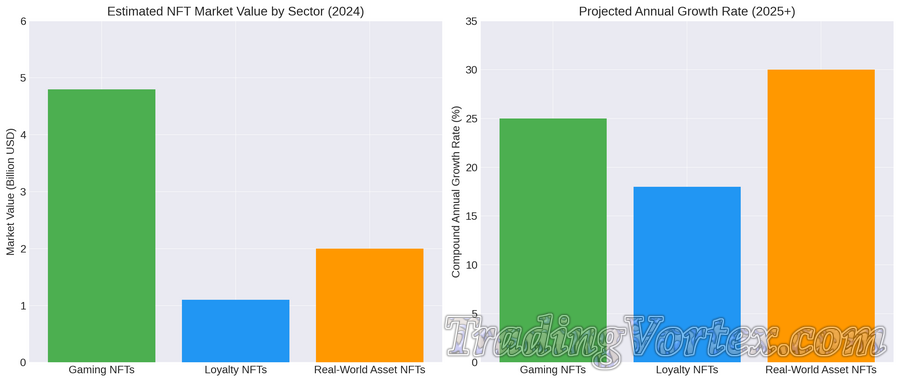 Top NFT Sectors in 2025: Market Value and Growth Outlook:
Top NFT Sectors in 2025: Market Value and Growth Outlook:
Chart 1: Estimated NFT Market Value by Sector (2024):
♦ Gaming NFTs: $4.8 billion
♦ Loyalty NFTs: $1.1 billion
♦ Real-World Asset NFTs: $2.0 billion
This illustrates the strong position of gaming in the NFT market, with RWAs and loyalty NFTs growing fast behind it.
Chart 2: Projected Annual Growth Rate (CAGR) by Sector (2025+):
♦ Gaming NFTs: 25%
♦ Loyalty NFTs: 18%
♦ RWA NFTs: 30%
Real-world asset NFTs are expected to grow at the fastest rate, reflecting growing institutional interest and asset tokenization trends.
Key Factors That Influence NFT Flipping Profits:
In the early days, flipping NFTs was a bit like throwing darts in the dark. You’d buy what looked cool, hope someone else thought it was cooler, and pray the floor price went up before your rent was due. Fast-forward to 2025, and things are a lot more structured, thankfully.
Today, successful flipping requires more than just good instincts. It demands strategy, tools, and a solid understanding of the broader trends shaping NFT value. So, if you want to stop flipping randomly and start flipping profitably, these are the key factors you absolutely need to keep in mind.
Cross-Chain Trading and Interoperable NFTs:
Why Flipping Across Blockchains Can Boost Your ROI?
If you’re still only flipping NFTs on one blockchain, you’re probably leaving money on the table. In 2025, some of the best opportunities come from understanding how different ecosystems work, and more importantly, how they connect.
NFTs are no longer confined to Ethereum. Projects are launching on Solana, Polygon, Avalanche, Arbitrum, and even Layer 2 solutions that cut gas fees dramatically. And here’s the exciting part: many of these NFTs are interoperable, meaning they can move or be mirrored across multiple blockchains.
This matters for three big reasons:
- More Buyers, More Liquidity: if your NFT can be listed on marketplaces across several chains, you’ve got access to a much larger audience. A buyer who missed the mint on Ethereum might happily grab it on Polygon if the price is right. That extra visibility can often mean better prices and faster flips.
- Lower Costs, Higher Margins: gas fees can kill profits. By flipping on chains with lower transaction costs, like Solana or Polygon, you keep more of your gains. Some traders are now minting and flipping on low-fee chains first, then bridging to premium chains once demand spikes.
- Arbitrage Opportunities: Here’s where things get really interesting. Cross-chain interoperability creates price discrepancies. The same NFT might be undervalued on one chain and selling at a premium on another. Smart traders are already exploiting these gaps. Buy low on one chain, bridge it, and sell higher elsewhere. That’s textbook flipping; powered by cross-chain strategy.
Bonus tip: Tools like LayerZero, Axelar, and Wormhole make bridging easier and safer than ever. If you’ve been intimidated by the idea of moving assets across chains, don’t be. Today’s platforms do most of the heavy lifting for you.
AI-Curated Collections and Dynamic Metadata:
How Evolving NFTs Are Creating New Flipping Strategies?
Back in the day, an NFT was just a picture on a blockchain. Once it was minted, that was it. No changes, no updates, no growth. Now, things have evolved, literally.
Enter dynamic NFTs, which can change their metadata based on specific triggers like time, user interaction, or real-world data. And when you combine these evolving NFTs with AI-curated platforms, flipping becomes a much more sophisticated game.
Let’s break it down:
- NFTs That Adapt Over Time: Imagine an NFT that “levels up” the longer you hold it, or one that evolves after completing certain tasks within a game or ecosystem. These features increase perceived value, especially in gaming or loyalty contexts. As the NFT becomes more powerful or rare, so does its resale potential.
- AI That Spots Hidden Gems: Platforms like Nansen, icy.tools, and newer AI-powered dashboards are now analyzing wallet behavior, rarity patterns, and social sentiment to help traders identify undervalued assets. AI doesn’t get emotional. It just crunches the data and flags potential flips based on metrics that matter.
- Better Timing, Smarter Entry: One of the hardest parts of flipping is knowing when to get in. AI tools help with that too. By monitoring real-time trends, mint volumes, and user activity, they can suggest optimal buying windows before prices spike. It's like having a market analyst working 24/7 just for your wallet.
In short, AI-curated strategies and dynamic NFTs are giving traders new ways to profit. Instead of relying on hype, you're using logic, automation, and evolving tech to make sharper moves.
Environmental, Legal, and Regulatory Trends:
Flip Smarter by Staying Informed and Compliant:
Nobody likes reading about rules and regulations, but if you want to keep your flipping game alive (and legal), you can’t afford to ignore this stuff.
Sustainability Is Becoming a Value Metric:
More traders — and especially brands — are prioritizing blockchains that are energy-efficient. Ethereum’s move to Proof-of-Stake helped, but chains like Tezos and Polygon are actively branding themselves as green alternatives. Some projects even advertise their environmental footprint as a core selling point.
If you’re flipping NFTs that align with sustainability goals, you’re not just doing good: you’re also appealing to eco-conscious buyers who are often willing to pay a premium.
Royalties and Platform Policy Shifts:
Remember when royalties were automatic and every sale supported the creator? That model is under pressure. Some marketplaces (like Blur and Magic Eden) are cutting royalties to attract volume, while others (like OpenSea) are trying to find a middle ground.
As a flipper, this matters because royalties eat into your profit. If you buy on a platform with enforced 10% royalties and sell on one with 0%, that’s a noticeable difference. Know your marketplace policies before you buy or list.
KYC and Regulatory Oversight Are Increasing:
In 2025, regulatory bodies across the globe are paying much more attention to NFTs. Some marketplaces now require KYC (Know Your Customer) verification, especially when dealing with high-value assets. Others are flagging wallets that appear to engage in wash trading or suspicious flipping activity.
Real Talk from a Trader’s Experience:
I once grabbed a dynamic NFT from a small game project that barely had any hype. Its metadata changed based on the holder’s in-game activity. I played for a bit, leveled it up, then listed it just before the project announced a tournament. Sold it for 3x. That trade worked because I understood the mechanics, watched for news triggers, and timed the flip around evolving utility.
I’ve also made the mistake of ignoring royalties. I flipped an NFT on OpenSea and didn’t factor in the 10% royalty. My profit? Almost zero after fees. That was a painful but important lesson.
Key Takeaways for Profit-Focused Flippers:
- Use cross-chain strategies to access more buyers, lower fees, and find arbitrage opportunities.
- Leverage AI tools and focus on dynamic NFTs to stay ahead of market trends and time your flips better.
- Stay compliant with environmental expectations, royalty structures, and platform regulations to avoid unnecessary losses or risks.
In today’s market, flipping NFTs is less about gambling and more about precision. The more you understand these key factors, the better your flips will be: not just in theory, but in your wallet.
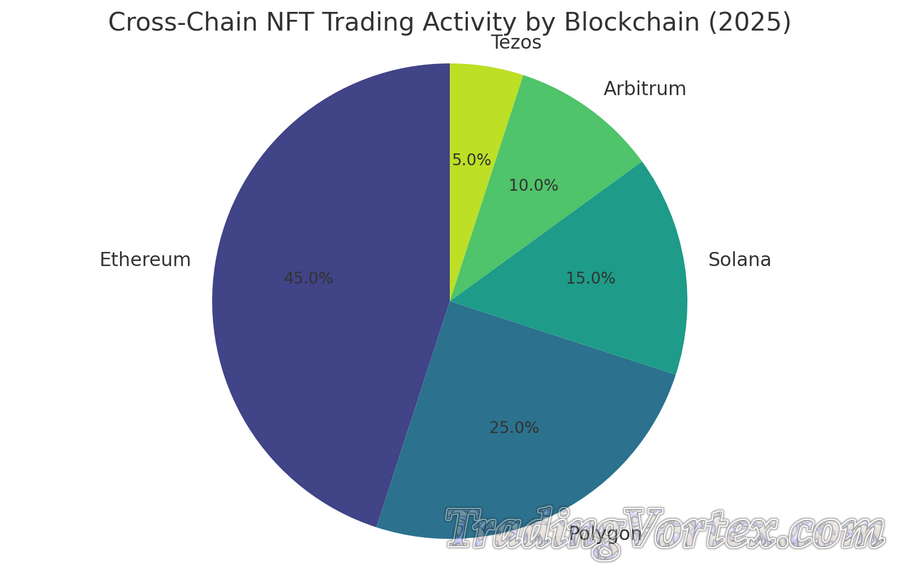 Cross-Chain NFT Trading Activity by Blockchain (2025): Shows how Ethereum, Polygon, Solana, Arbitrum, and Tezos are splitting user activity. Ethereum still leads, but lower-cost chains like Polygon and Solana are becoming important for flippers.
Cross-Chain NFT Trading Activity by Blockchain (2025): Shows how Ethereum, Polygon, Solana, Arbitrum, and Tezos are splitting user activity. Ethereum still leads, but lower-cost chains like Polygon and Solana are becoming important for flippers.
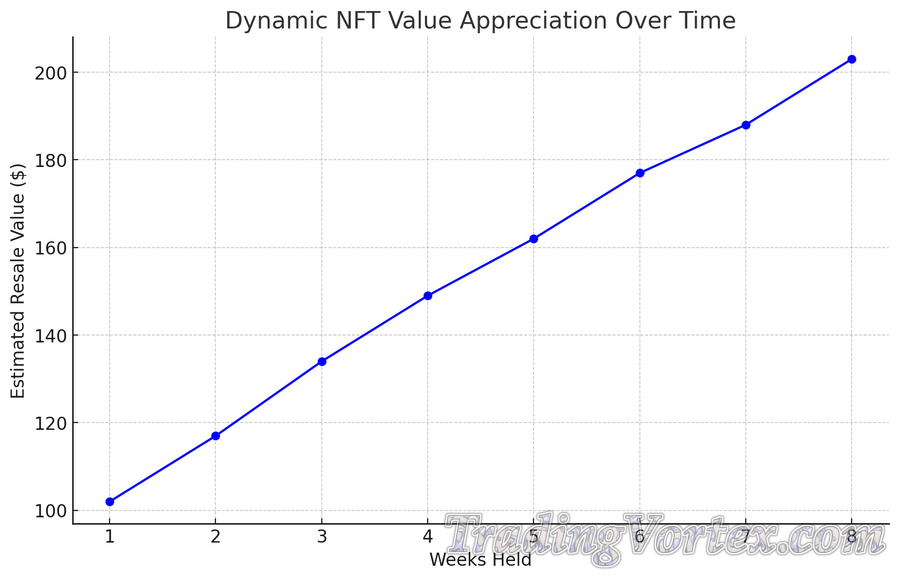 Dynamic NFT Value Appreciation Over Time: Illustrates how dynamic NFTs can grow in value with time and interaction, especially when tied to gamified or staking mechanisms.
Dynamic NFT Value Appreciation Over Time: Illustrates how dynamic NFTs can grow in value with time and interaction, especially when tied to gamified or staking mechanisms.
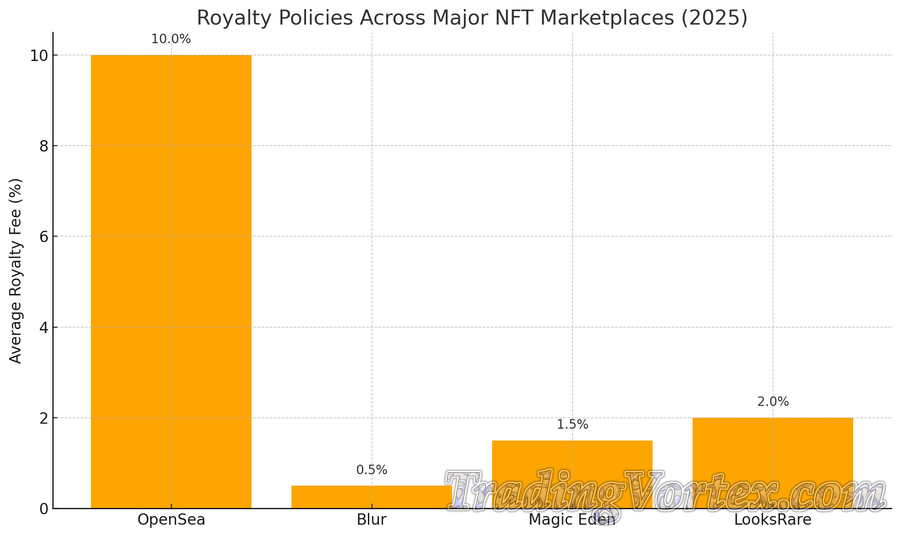 Royalty Policies Across Major NFT Marketplaces (2025): Compares average royalty fees, highlighting how traders need to factor in marketplace policies before flipping NFTs.
Royalty Policies Across Major NFT Marketplaces (2025): Compares average royalty fees, highlighting how traders need to factor in marketplace policies before flipping NFTs.
Risks and Challenges in NFT Flipping Today:
Let’s get real for a moment. NFT flipping sounds like easy money on the surface; buy low, sell high, walk away smiling. But anyone who’s been in the trenches knows it’s not always that simple. The reality is that this space, while still full of opportunity, also comes with a fair share of risks and unpredictable turns.
If you want to flip NFTs profitably and sustainably in 2025, you need to know the traps that are still catching even experienced traders off guard. Let’s walk through them together.
Market Manipulation and Wash Trading in 2025:
Let’s start with the elephant in the blockchain: wash trading.
So why does this matter to you as a flipper? Because chasing inflated collections is a quick way to lose money. Once the manipulation stops, demand crashes, floors tank, and you're left holding the bag, or more accurately, the JPEG.
Red Flags to Watch For:
- A handful of wallets doing most of the buying and selling
- Sudden, short-lived volume spikes with no real news
- Repetitive trades at nearly the same price
- No Discord engagement or organic community activity
What You Can Do:
Use tools like Nansen, Icy Tools, or NFTGo to spot wallet connections and check volume patterns. Trust your gut, but also check the data. A collection with real engagement, utility, and transparent ownership is always a safer bet than one simply topping the charts.
Marketplace Royalties and Platform Shifts:
Ah, royalties: the once-stable foundation that’s now become a moving target.
Originally, NFT royalties meant that creators earned a percentage from every resale. It was seen as revolutionary. But in 2025, things have changed. Some marketplaces like Blur and Magic Eden dropped royalty enforcement altogether to attract volume, while others, like OpenSea, have tried to uphold creator payments but with wavering success.
Yuga Labs even launched its own royalty-focused marketplace to keep things consistent. But for traders, all of this has added new complexity to the flipping game.
Why It Matters for Traders:
If you're flipping NFTs and ignoring royalty structures, you're risking your profits. A 10 percent royalty, on top of platform fees and gas, can turn a solid flip into a breakeven, or worse.
And when projects migrate from one platform to another, liquidity can split, floor prices can stagnate, and resale opportunities can disappear overnight.
How to Stay Ahead:
- Always check the royalty terms before buying
- Use platforms that clearly disclose royalty breakdowns
- Stay updated on where your target collections are primarily traded
- Consider favoring collections with in-house or on-chain royalty enforcement for clearer profit margins
NFT Taxes and Legal Compliance Risks:
Let’s talk taxes. Not the most exciting topic, I know, but ignoring it is like flipping with a blindfold.
What This Means for You:
- You need to track your cost basis, sale price, and holding period for every trade
- Mistakes or neglect can lead to fines, audits, or worse
- Legal gray areas still exist, especially for staking rewards, royalties, and cross-border activity
How to Stay Compliant Without Losing Sleep:
- Use tax tools like CoinTracker, TokenTax, or Koinly to automate recordkeeping
- Consult a crypto-savvy tax advisor, especially if you trade at volume
- Plan trades with taxes in mind; sometimes, holding a little longer can save you a lot
- Be mindful of KYC requirements on platforms, especially if you’re flipping high-value NFTs
A Real-World Lesson from the Flip Side:
In late 2024, I flipped an NFT tied to a utility token with monthly staking rewards. The flip itself was clean: bought low, sold high. But guess what? I completely forgot that the staking income counted as taxable, too. That one oversight nearly wiped out half of my gains once I filed taxes in early 2025.
I’ve also been caught off guard by royalty enforcement; or the lack of it. I listed an NFT assuming a 2.5 percent royalty, only to discover after the sale that the platform had recently updated to 10 percent, and I hadn’t read the new policy. That mistake hurt, but I learned fast.
Key Takeaways to Flip Smart in 2025:
| Risk Area | Why It Matters | How to Manage It |
|---|---|---|
| Market manipulation | Fake hype leads to overpaying and losses | Analyze wallets, watch volume patterns |
| Royalty uncertainty | Profits can vanish due to changing fees | Check marketplace rules before buying |
| Tax and legal compliance | Improper reporting can cost you big | Track every trade, automate tax reporting |
Flipping NFTs can still be highly profitable, but only if you know how to avoid the landmines. By staying informed, cautious, and just a little paranoid, you can protect your profits and avoid sleepless nights come tax season.
This is not about playing scared: it’s about flipping smart. The more you treat this like a business instead of a game, the more consistent your success will be.
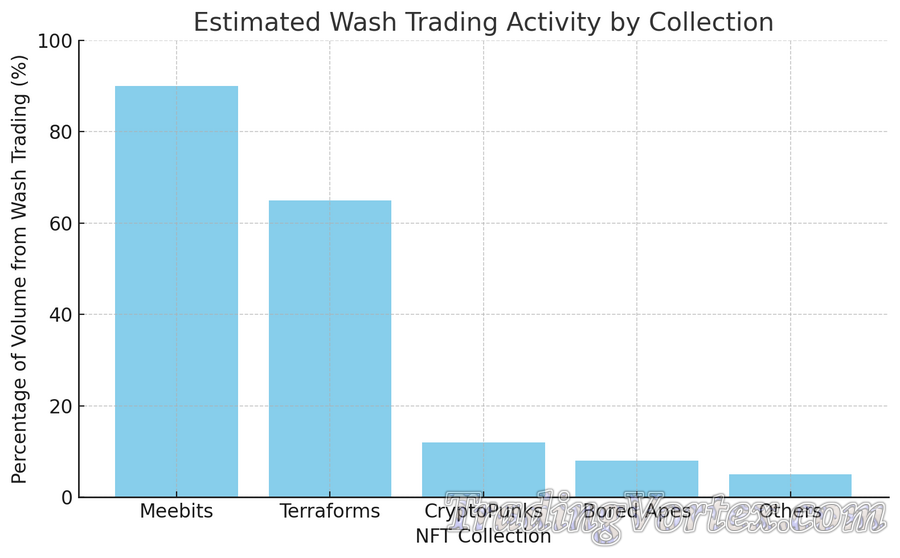 Estimated Wash Trading Activity by Collection: This chart highlights how some well-known NFT collections, such as Meebits and Terraforms, have had alarmingly high volumes of wash trading: sometimes exceeding 90 percent. This emphasizes the need for flippers to dig deeper into volume quality before making decisions.
Estimated Wash Trading Activity by Collection: This chart highlights how some well-known NFT collections, such as Meebits and Terraforms, have had alarmingly high volumes of wash trading: sometimes exceeding 90 percent. This emphasizes the need for flippers to dig deeper into volume quality before making decisions.
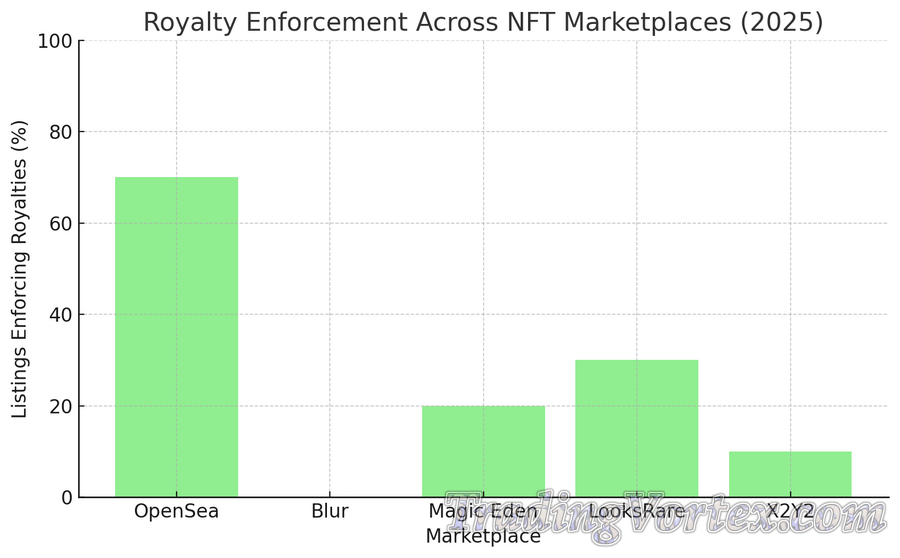 Royalty Enforcement Across NFT Marketplaces (2025): This visual shows how royalty enforcement varies across major platforms. While OpenSea still enforces royalties on a majority of listings, platforms like Blur have completely dropped them, significantly affecting net profit for flippers.
Royalty Enforcement Across NFT Marketplaces (2025): This visual shows how royalty enforcement varies across major platforms. While OpenSea still enforces royalties on a majority of listings, platforms like Blur have completely dropped them, significantly affecting net profit for flippers.
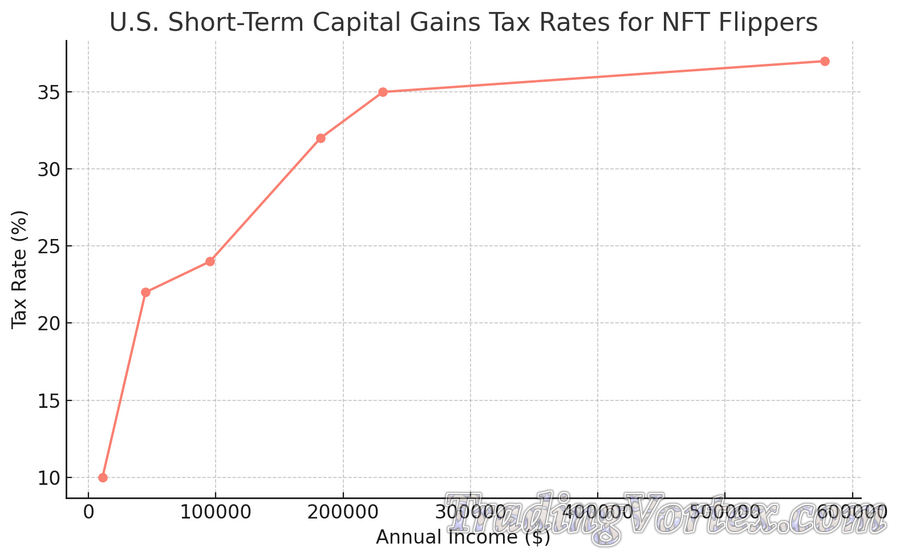 U.S. Short-Term Capital Gains Tax Rates for NFT Flippers: This chart illustrates how your annual income level affects how much you’re taxed on short-term NFT flips in the United States. As you move up in income brackets, your tax rate climbs; making it crucial to plan flips and holding periods accordingly.
U.S. Short-Term Capital Gains Tax Rates for NFT Flippers: This chart illustrates how your annual income level affects how much you’re taxed on short-term NFT flips in the United States. As you move up in income brackets, your tax rate climbs; making it crucial to plan flips and holding periods accordingly.
Most Profitable NFT Flipping Strategies for 2025:
Flipping NFTs in 2025 isn’t about chasing shiny objects anymore. The “buy anything and hope for the best” era is over. What’s working now is far more refined: it’s strategic, data-driven, and built around real value. Whether you’re flipping for fun or building a long-term trading side hustle, these are the strategies smart traders are leaning on this year.
Let’s dive into what actually works in today’s market.
Focus on NFTs with Real Utility and Long-Term Value:
Here’s the truth: hype dies fast, but utility lasts.
Utility-driven NFTs offer more than just a cool image. They give holders something tangible: whether that’s access to events, revenue-sharing models, in-game perks, exclusive memberships, or loyalty benefits.
Examples in 2025 include:
- Membership NFTs that unlock real-world access, VIP lounges, or exclusive token drops
- Gaming assets that can be played, rented, or upgraded before resale
- Staking-enabled NFTs that generate passive income while you wait for the right flip window
- Royalties-bearing NFTs that give holders a share of secondary sales or content usage
One of the most profitable flips I made this year involved a media creator pass NFT. It gave me early access to tools and plugins, and also dropped monthly utility tokens. The hype came later, but the value was baked in from the start.
If you want sustainable flips, buy into utility. Someone will always pay more for an NFT that does something useful.
Flip Fractionalized NFTs and Tokenized Real-World Assets:
Not everyone has 10,000 dollars to spend on a rare NFT or a blue-chip collectible. That’s where fractional NFTs and tokenized real-world assets (RWAs) come in. These let you invest in small, tradeable shares of bigger, valuable assets like luxury art, real estate, vintage collectibles, or music royalties.
This model has exploded in 2025, with platforms like Particle, RWA.xyz, and Arkive leading the charge.
Here’s how traders are profiting:
- Buying fractions of high-value NFTs when interest is low
- Holding until a catalyst (exhibit, media coverage, or listing) increases demand
- Selling the fractional stake at a premium when attention builds
The beauty is in the low entry cost and clear flip opportunity. I picked up a fraction of a tokenized Banksy piece and flipped it within two months after it was featured in a major virtual gallery event. My profit was nearly double, and I never needed to own the whole thing.
Fractional flipping is low-risk, high-reward if timed right.
Use DeFi Tools to Boost NFT Flip Returns:
Welcome to NFT-Fi: where your NFTs aren’t just assets, they’re money-making tools.
In 2025, you can use NFTs in all sorts of DeFi scenarios before flipping them:
- Stake them to earn passive income or governance tokens
- Use them as collateral for crypto loans
- Rent them out through smart contracts to earn income while still holding ownership
Platforms like JPEG'd, ReNFT, and Astaria are helping traders squeeze extra value out of NFTs between buy and sell.
Here’s a real example: I held a rare game item NFT I didn’t plan to flip for a few months. Instead of letting it sit idle, I rented it out to a play-to-earn guild and made steady passive income. When a new game season launched and prices jumped, I sold it for a profit; stacking gains on both ends.
The takeaway: earning while holding gives you flexibility and patience. You can wait for the right moment to sell, instead of rushing a flip out of FOMO or fear.
Exploit Cross-Chain Arbitrage Opportunities:
Here’s one most casual traders miss: the same NFT can have different prices on different blockchains.
If an NFT collection is minted or bridged across Ethereum, Solana, Polygon, or other chains, liquidity and demand might vary from one chain to another. That creates pricing gaps: opportunities for smart flippers.
Here’s how cross-chain arbitrage works:
- You spot an NFT priced at 0.3 ETH on Polygon
- The same collection is listed at 0.45 ETH on Ethereum
- You buy the cheaper one, bridge it (or list it via a multi-chain platform), and sell at the higher price
In 2025, cross-chain tools like LayerZero, Wormhole, and Arcana make this smoother than ever. Some even offer gasless bridging or unified listings to speed up the process.
One time, I noticed a pricing mismatch on a music NFT between Avalanche and Ethereum. I bought three cheap copies on Avalanche, bridged them, and flipped them within hours on Ethereum for 20 percent profit each. All in one afternoon.
This method takes a bit of setup, but once you’ve got the tools, it becomes second nature.
Leverage AI and Analytics for Better Flip Timing:
Let’s be honest, even experienced flippers make bad calls. We misread sentiment, buy too early, or sell just before a pump. That’s where AI and real-time analytics give you an edge.
Platforms like Nansen, CryptoSlam, TokenMetrics, and AI-driven dashboards are helping traders:
- Track smart money and whale wallet activity
- Predict hype spikes based on social sentiment and Twitter/X data
- Identify rising collections before they hit trending charts
- Score NFTs based on rarity, engagement, and buying patterns
The result? You don’t need to guess anymore. You can let the data guide you.
I once used an AI alert system to catch a small collection gaining traction among verified influencer wallets. I bought in early, and within three days the floor doubled. Without those signals, I would’ve missed it entirely.
AI won’t guarantee profit, but it helps you trade with confidence instead of hope.
Quick Strategy Recap:
| Strategy | Why It Works | Pro Tip |
|---|---|---|
| Utility-first NFTs | Deliver real-world value and consistent demand | Look for projects offering perks, rewards, or access |
| Fractionalized and tokenized assets | Affordable entry into high-value NFTs | Time exits around news, partnerships, or exhibits |
| NFT-Fi and staking integrations | Earn while you wait to flip | Use rental and staking platforms between trades |
| Cross-chain arbitrage opportunities | Leverage price differences between ecosystems | Monitor bridgeable collections across chains |
| AI and analytics-driven flipping | Take the guesswork out of entries and exits | Track whale wallets, rising communities, and rarity |
Final Thoughts from a Flipper in the Field:
Flipping NFTs in 2025 is no longer a blind gamble. It's a combination of research, timing, tool usage, and most importantly, patience.
I’ve made some of my best trades not by reacting to hype, but by staying calm, waiting for utility to kick in, and using data instead of emotion. The flips that feel boring at first — the ones where you know the math works, the use case is strong, and the upside is likely — those are the ones that tend to pay off.
So before your next flip, ask yourself:
- What real value does this NFT bring?
- How long am I willing to hold?
- Can I earn something while I wait?
- Is the data on my side?
If you can answer those clearly, you’re flipping like a pro, not just riding a trend.
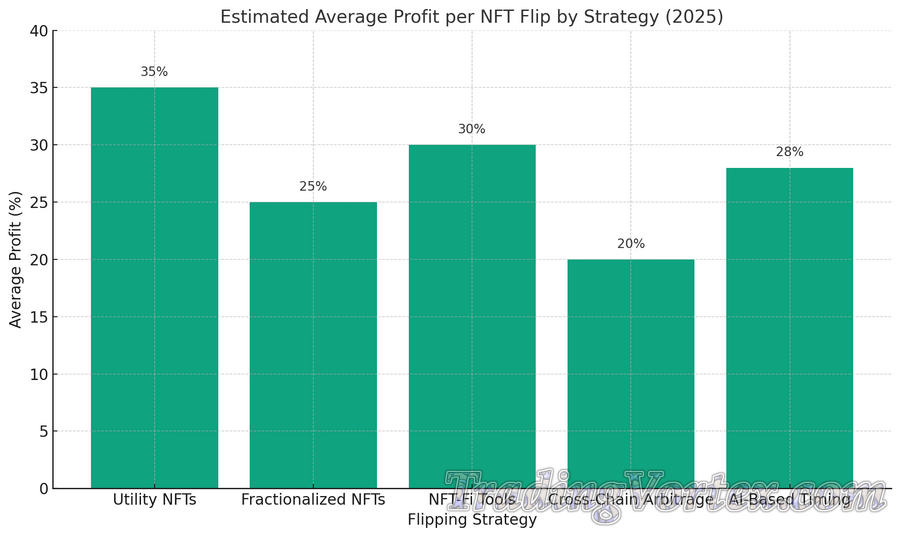 A visual breakdown of the estimated average profit per NFT flip by strategy in 2025. As shown:
A visual breakdown of the estimated average profit per NFT flip by strategy in 2025. As shown:
♦ Utility-based NFTs lead the pack with the highest profit margins, thanks to their ongoing value and user demand.
♦ NFT-Fi tools also offer strong returns, particularly when flipping is paired with staking or lending.
♦ AI-powered timing and fractionalized NFTs follow closely behind, offering consistent upside with lower entry risks.
♦ Cross-chain arbitrage remains profitable but slightly more competitive, requiring speed and technical setup.
This chart can help prioritize your flipping efforts based on what delivers the strongest results today.
Essential Tools and Tips for Smarter NFT Flipping:
Let’s face it: flipping NFTs in 2025 isn’t about luck anymore. The market has matured, and so have the strategies. If you want to make flipping profitable and sustainable, you need more than just a MetaMask wallet and a Twitter feed. You need reliable tools, the right habits, a solid network, and, most importantly, a smart approach to risk.
Think of this as your go-to toolkit. Whether you’re just getting your feet wet or you’ve already flipped your way to a decent profit, these tools and tips will sharpen your edge and help you avoid costly mistakes.
Diversify Your NFT Portfolio by Category:
If all your NFTs look the same or come from a single trend wave, you’re playing a dangerous game. One change in sentiment can tank your entire portfolio. That’s why diversification isn’t just a traditional finance tactic: it’s just as critical in NFT flipping.
Here’s how to think about diversification:
- Art NFTs: Still relevant, especially if the artist has long-term brand equity
- Gaming NFTs: Offer strong flip potential when tied to in-game economies
- Access NFTs: Memberships, educational passes, and event tokens often come with real-world perks
- Fractionalized NFTs and RWAs: Allow low-risk entry into high-value asset flipping
- Phygital NFTs: Linked to physical products with redeemable utility or collectibles
You don’t need to own one of everything, but spreading your bets across different types gives you flexibility and protection. If the gaming market cools off, maybe your music or real estate-backed NFTs will hold the line.
Personal Tip: I keep separate wallets labeled by type: “Art Stack,” “Gaming Inventory,” “Utility & Access,” and “Speculative.” This helps me track performance and avoid impulsive flips when one sector gets noisy.
Best Tools for Tracking, Research, and Price Alerts:
Now let’s talk tools. The right dashboard can save you hours of research, spot flips before they become obvious, and even automate parts of your trading. Here are the platforms I swear by:
- Nansen.ai: Tracks wallet behavior from known “smart money” traders, provides real-time alerts, and flags emerging trends before the herd arrives.
- NFTGo.io: A complete analytics suite for floor prices, rarity, mint activity, volume spikes, and project health. It also rates collections using AI to flag early movers.
- Icy.tools: Best for real-time alerts on new mints, wallet activity, and price movements. If you want to snipe new projects or track a particular whale’s activity, this is your tool.
- Rarity.tools: Focuses on identifying rare traits and calculating rarity scores across NFT collections. Great for spotting undervalued items others might overlook.
- TraitSniper: If you’re flipping based on rarity, TraitSniper helps you catch deals fast by offering snipe alerts and trait-based filters. It’s like having a radar for rare NFTs.
- Reservoir: This lets you track listings across multiple marketplaces like OpenSea, Blur, LooksRare, and Magic Eden. Great for price comparison and faster flipping execution.
- Moby, Ninja Alerts, and Floor: Push notifications for wallet movements, drop announcements, and floor changes. Use these when you want to act before others even realize something’s happening.
Pro Tip: Set up multi-channel alerts (email, app, Discord bots) so you’re not missing opportunities while you sleep or scroll TikTok. Timing really is everything in flipping.
Build an Edge with Community Access and Networking:
If tools help you see what’s happening, communities help you understand why.
NFT flipping still thrives on insider signals, alpha leaks, and strong community momentum. Being plugged into the right circles can mean the difference between buying late and catching a collection before it explodes.
Where to plug in:
- Project Discord servers: This is where founders often drop early hints, reveal utilities, or announce upcoming rewards
- Twitter/X Spaces: Live chats are goldmines for real-time sentiment and market talk
- Alpha groups and DAO circles: More serious groups often share spreadsheets, market strategies, and wallet tracking insight
- Launchpads and whitelists: Joining early supporter groups can grant you exclusive mint access at floor prices
Real Talk: I once joined a lesser-known Discord during a lull in NFT volume. That one group pointed me toward a mint that later did a 4x in three days. I would’ve missed it entirely if I wasn’t active in that community.
Don’t underestimate the power of just showing up and participating. The more helpful and engaged you are, the more likely you’ll get added to early access lists and behind-the-scenes convos.
Protect Your Profits with Smart Risk Management:
Flipping NFTs without risk management is like driving fast with no brakes. Sure, you might win a few races, but eventually you’ll crash; and it’ll hurt.
Here’s how to keep your flipping game safe and sustainable:
- Use Multiple Wallets: Keep separate wallets for long-term holds, flips, and speculative plays. This prevents emotional decisions and limits exposure if one wallet gets compromised.
- Enable 2FA and Use Hardware Wallets: Don’t store valuable NFTs on hot wallets connected to dApps or Discord links. Use cold wallets like Ledger or Trezor for anything worth more than a couple hundred dollars.
- Always Verify Contracts Before Minting: New projects can be rug pulls or malicious clones. Use tools like Etherscan or Blockscout to inspect contract history, ownership, and interactions. If you don’t understand what the contract does, don’t sign it.
- Set Exit Targets Before You Buy: Know your profit goals and exit triggers before you enter a trade. Whether it’s a 20 percent gain or a particular event (like airdrop claim or announcement), define your move so you’re not swayed by emotions or hype.
- Track Your Taxes and Trade History: Use tax tools like CoinTracker, Koinly, or Accointing to log each flip. In many jurisdictions, every sale — even NFT to NFT swaps — triggers a taxable event. Stay ahead so tax season doesn’t sneak up and wreck your gains.
Quick Recap Table:
| Category | Tools & Practices | Why It Matters |
|---|---|---|
| Portfolio Diversification | Mix art, gaming, access, RWA NFTs | Reduces volatility, broadens opportunity |
| Market Analytics | Nansen, NFTGo, Icy.tools, Reservoir, TraitSniper | Catch trends early, time entries, and exits smartly |
| Community Networking | Discord, Twitter Spaces, alpha groups, DAOs | Get early access, stay informed, build flipping allies |
| Risk Management | Hardware wallets, contract checks, profit targets | Protects gains and reputation, prevents careless losses |
Final Thought from the Flip Side:
You don’t need to flip every day to win. Sometimes your best trade is the one you didn’t make because you had the discipline, data, and support system to wait.
Use these tools and tips not just to flip faster, but to flip smarter. Your wallet will thank you later.
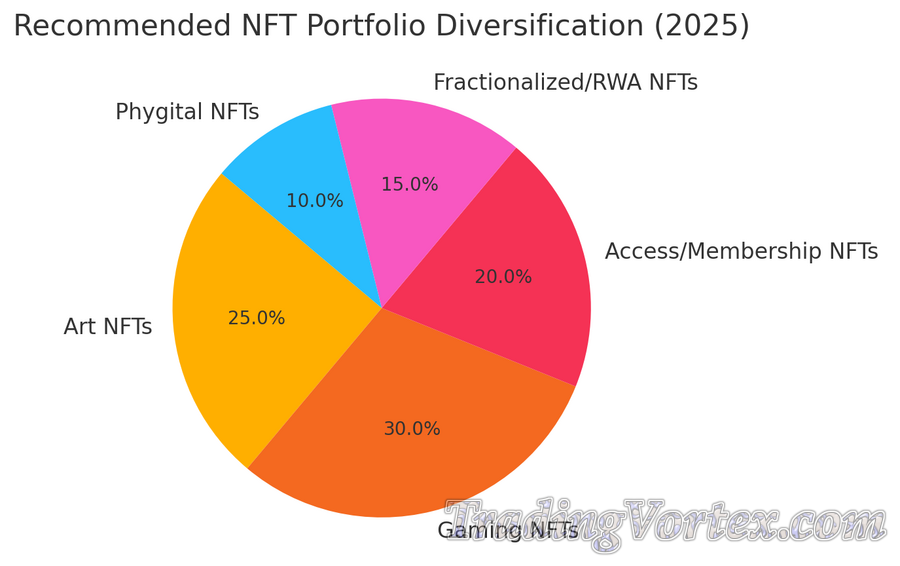 Recommended NFT Portfolio Diversification (2025): Shows an ideal distribution across different NFT categories to reduce risk and capture multiple market trends.
Recommended NFT Portfolio Diversification (2025): Shows an ideal distribution across different NFT categories to reduce risk and capture multiple market trends.
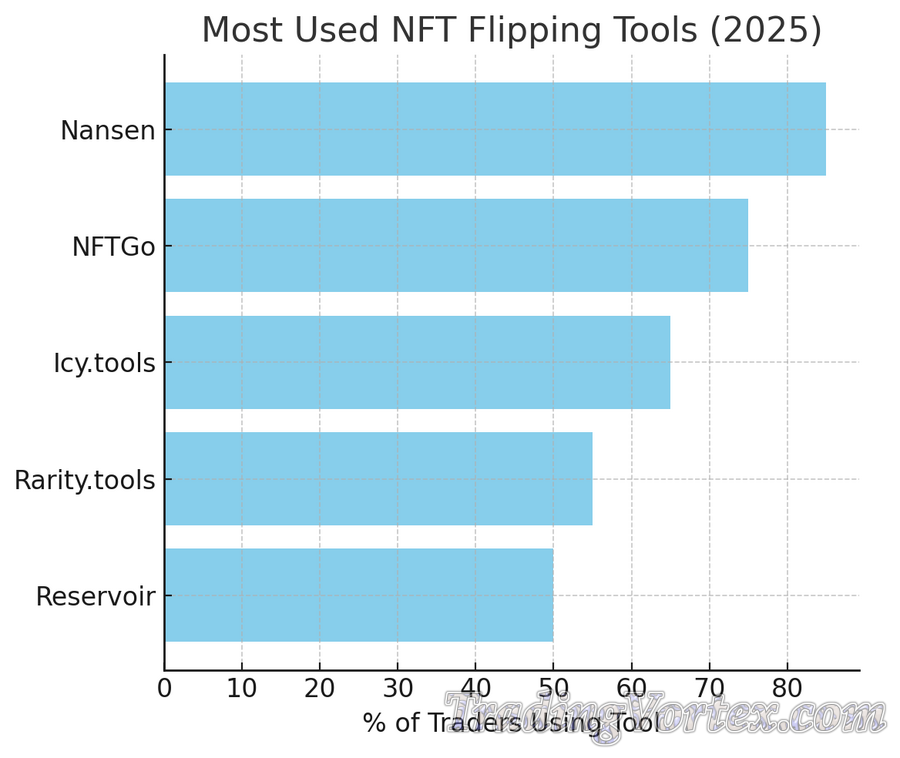 Most Used NFT Flipping Tools (2025): Highlights popular analytics and alert tools traders are relying on to identify profitable flips before they go mainstream.
Most Used NFT Flipping Tools (2025): Highlights popular analytics and alert tools traders are relying on to identify profitable flips before they go mainstream.
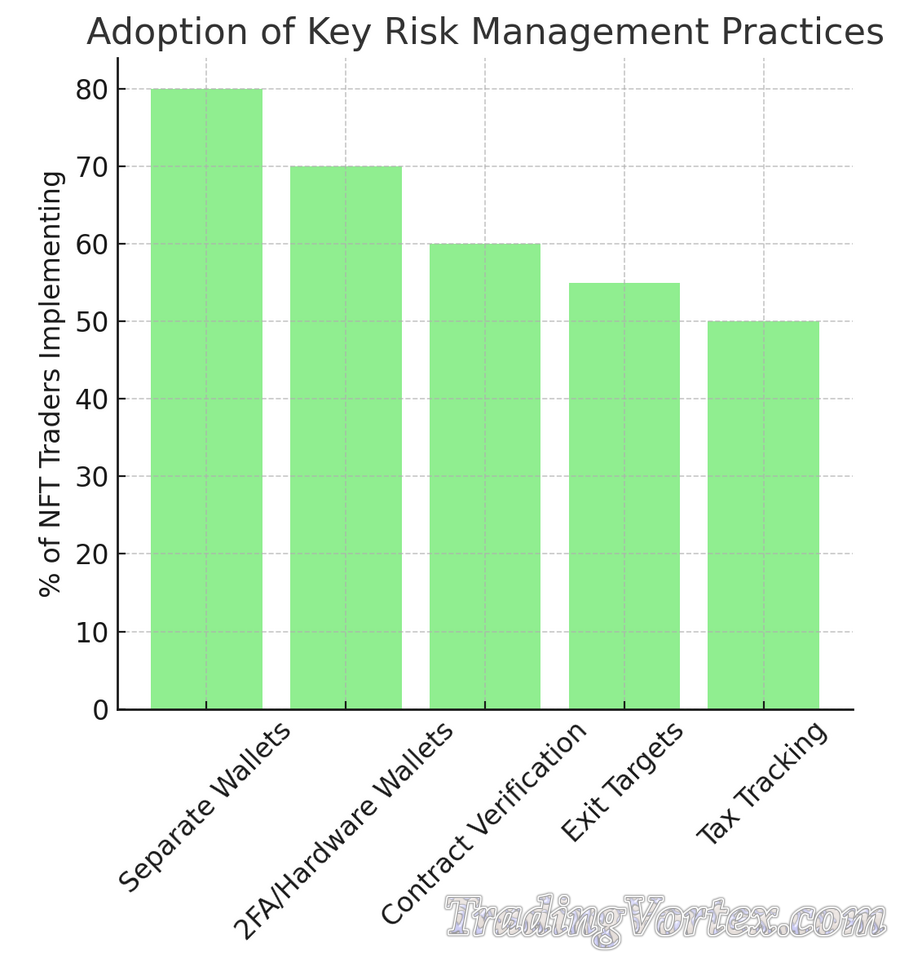 Adoption of Key Risk Management Practices: Illustrates how many traders are using best practices like wallet segmentation, 2FA, smart contract checks, and tax tracking to protect their profits.
Adoption of Key Risk Management Practices: Illustrates how many traders are using best practices like wallet segmentation, 2FA, smart contract checks, and tax tracking to protect their profits.
Real‑World NFT Flipping Success Stories:
Nothing teaches better than real examples. These flips prove that profitable NFT strategies in 2025 aren’t fluff: they’re grounded in strategy, timing, and an understanding of market mechanics.
CryptoPunks – Blue‑Chip Resurgence and Million-Dollar Flips:
CryptoPunks continued to dominate high-value NFT sales in 2025. In May, CryptoPunk #3609, one of just 88 Zombie Punks, sold for 440 ETH, or around $1.11 million. That was the top sale of the month, and 13 of the top 15 NFT transactions were also Punks. In July, CryptoPunks exploded with a weekly trading volume of over $24.6 million, up more than 400 percent from the previous week. The floor price jumped from around 40 ETH to 47.5 ETH, translating to about $180,000 per Punk. That spike followed GameSquare’s acquisition of Punk #5577 for $5.15 million in preferred stock, signaling that blue-chip NFTs are now viewed as real treasury assets.
Why it worked: Legacy, cultural significance, strong liquidity, and institutional validation. Flipping CryptoPunks in 2025 is less about chasing trends and more about riding certainty.
Gaming NFT Flip – Axie Infinity Breeding Strategy:
While less dramatic than Punk flips, gamers are still making impressive returns by breeding and trading rare Axies. A smart trader flipped rare Axies bred on the Ronin chain, capitalizing on gameplay updates and tournament seasons. Price gaps emerged during low-activity periods, and flipping during post-update spikes led to solid double-digit gains.
Lesson: Align your flip timing with in-game events and marketplace patterns. When marketplace volume dips before updates, it’s time to buy. When buzz builds post-update, it’s time to sell.
DeFi-NFT Success – Yield + Flip Combo:
Some NFTs in 2025 offer more than aesthetic appeal: they generate passive income. Utility-based NFTs tied to staking, airdrops, or revenue-sharing have become popular flip targets. Smart flippers grab them early, collect rewards, and sell after demand rises from an airdrop or project expansion.
Takeaway: Look for NFTs that provide income while you hold, then flip them after the market wakes up. Earning while waiting reduces risk and increases returns.
Fractionalized NFT Flips – Tokenized Art in Action:
Fractional ownership of real-world assets is thriving. Platforms offering fractional NFTs tied to fine art, collectibles, or real estate have seen massive growth. In one example, a trader bought a 1 percent share of a digital artwork before it was featured in a virtual gallery. Within two weeks of the exhibit, that fractional share doubled in value.
Why it worked: Entry cost was low, the asset had proven value, and a high-profile event sparked a surge in attention. It’s flipping with minimal exposure and clear upside.
What Elite Flippers Do Differently in 2025:
Here’s what consistently successful NFT flippers are doing today:
- Diversifying across categories: They flip blue-chips, gaming assets, utility NFTs, and fractional RWAs to reduce volatility.
- Timing around catalysts: Drops, token launches, DAO votes, and high-profile announcements are flipping signals.
- Staying connected: Active participation in Discords, DAOs, and Twitter communities gives them early insights.
- Using data tools: Analytics platforms help track whale activity, monitor floor trends, and snipe rare traits.
Personal Field Note from My Flips:
Last spring, I picked up a fractional art token on KnownOrigin for around $60,000. When the piece was featured in a metaverse gallery, I sold my share within ten days for nearly double the price. The keys were buying quality, anticipating exposure, and exiting on the momentum wave. No guesswork; just strategy and timing.
Top Lessons from These Success Stories:
| Success Story Type | Strategy Insight | Why It Worked |
|---|---|---|
| CryptoPunks Blue-Chip Flips | Bet on scarcity, legacy, and demand | Reliable liquidity and cultural credibility |
| Axie Infinity Gaming Flips | Time trades around game events | Volume spikes gave clear exit points |
| Utility / DeFi NFT Flips | Earn yield while preparing for resale | Dual-income flipping model improved ROI |
| Fractionalized RWA Flips | Buy low-cost shares of valuable assets | Event exposure turned interest into profit |
These success stories show that in 2025, flipping NFTs isn’t about chasing hype. It’s about strategic positioning, good timing, and smart use of tools and insights. Whether you're flipping million-dollar Punks or low-entry fractional tokens, the key is to buy value before the crowd sees it, and sell once they catch on.
What’s Next? Emerging NFT Flipping Opportunities:
Wondering where the next big flipping opportunities lie? In 2025, NFTs are moving from art collectibles into tech-driven, utility-packed assets. These emerging categories will shape profitable trades in the year ahead. Here’s where smart traders are looking next:
AI-Generated & Smart NFTs (iNFTs) – The Future Is Evolving:
AI-powered NFTs are evolving from static art into intelligent creatures that interact and adapt. These smart NFTs change based on data events or user actions, sometimes evolving their traits over time. Dynamic NFTs demand price premiums of 120–300% over static ones, according to recent market data.
Flipping edge: Get in early on AI-generated collections before utility unlocks or traits evolve. Sell once they display growth, uniqueness, or social traction. It’s flipping logic, not art curiosity, that gives you the edge.
Metaverse Land & Virtual Asset Flips – Digital Real Estate Is Heating Up:
Virtual land remains one of the most promising asset classes on-chain. Forecasts expect the global digital land market to grow from around $4 billion in 2025 to over $67 billion by 2034. Traders who snapped up early plots near developing clusters in platforms like Decentraland or Sandbox and flipped them after brand activations saw triple-digit returns recently.
Flipping edge: Identify rising neighborhoods before events or branded builds launch. Rent or develop plots for income, then flip during peak interest periods.
Brand-Backed Utility NFTs & Phygital Collectibles:
Established brands are diving into NFTs for loyalty, marketing, and physical-digital integration. Drops tied to physical goods (like digital twins or wearable NFTs) have demonstrated strong resale potential, especially when backed by partnerships with fashion and entertainment companies.
Flips tied to these utility drops often pay off when demand builds post-launch campaigns or brand expansions.
Institutional Adoption & Real-World Asset Tokenization (RWA):
Institutional interest in NFT-backed assets and tokenized real-world collectibles continues to grow. Venture investment in NFT infrastructure topped $2.1 billion in 2025, heavily focused on utility platforms rather than speculative NFTs. Tokenized luxury cars, music royalties, and real estate allow fractional ownership, and flipping happens when media attention or secondary demand spikes.
Flip edge: Watch fractional assets tied to institutional movements or licensing deals for timely exit opportunities.
Membership, Identity, Game Interoperability & DePIN Access NFTs:
New utility areas offer flipping angles beyond art and land:
- Membership and Identity NFTs serve as cross-platform credentials for decentralized social networks and services.
- Interoperable Gaming Assets that work across multiple games or platforms are gaining traction, unlocking broader value.
- DePIN (Decentralized Physical Infrastructure Networks) NFTs provide access to IoT services like Wi-Fi nodes or energy sharing.
- Phygital collectibles combine physical items with digital twin NFTs, and gain flipping value when the physical utility or brand grows.
Personal Note: Why I’m Betting on These Trends?
In 2025, I flipped a dynamic NFT that earned staking yield while evolving with AI triggers. When the utility journey became visible, I sold for a premium. Another time, I speculated on virtual wearables in an emerging neighborhood before a major brand activation, and profited after the neighborhood buzzed. Success came down to spotting utility trajectories early; not chasing hype.
Emerging Opportunity Summary:
| Emerging Category | What to Watch For | Flipping Strategy |
|---|---|---|
| AI-Powered iNFTs | Early evolving traits, user interactivity | Flip post-evolution or social growth phase |
| Virtual Real Estate | Neighborhood growth, brand events | Flip or lease during exposure spikes |
| Brand-Minted Utility NFTs | Campaign-backed drops, physical-digital tie-ins | Buy early, flip once secondary demand rises |
| Tokenized Real-World Assets | Institutional support, licensing deals | Flip on visibility from events or secondary trades |
| Identity, Gaming & DePIN NFTs | Cross-platform access, service activation | Flip when new access layers or ecosystems unlock |
2025 flipping opportunities extend far beyond JPEG speculation: they revolve around smart integrations, interactive tech, and real-world bridging. If you’re watching AI-powered NFTs, virtual land growth, brand utility collections, or tokenized asset platforms, you're already ahead of the crowd.
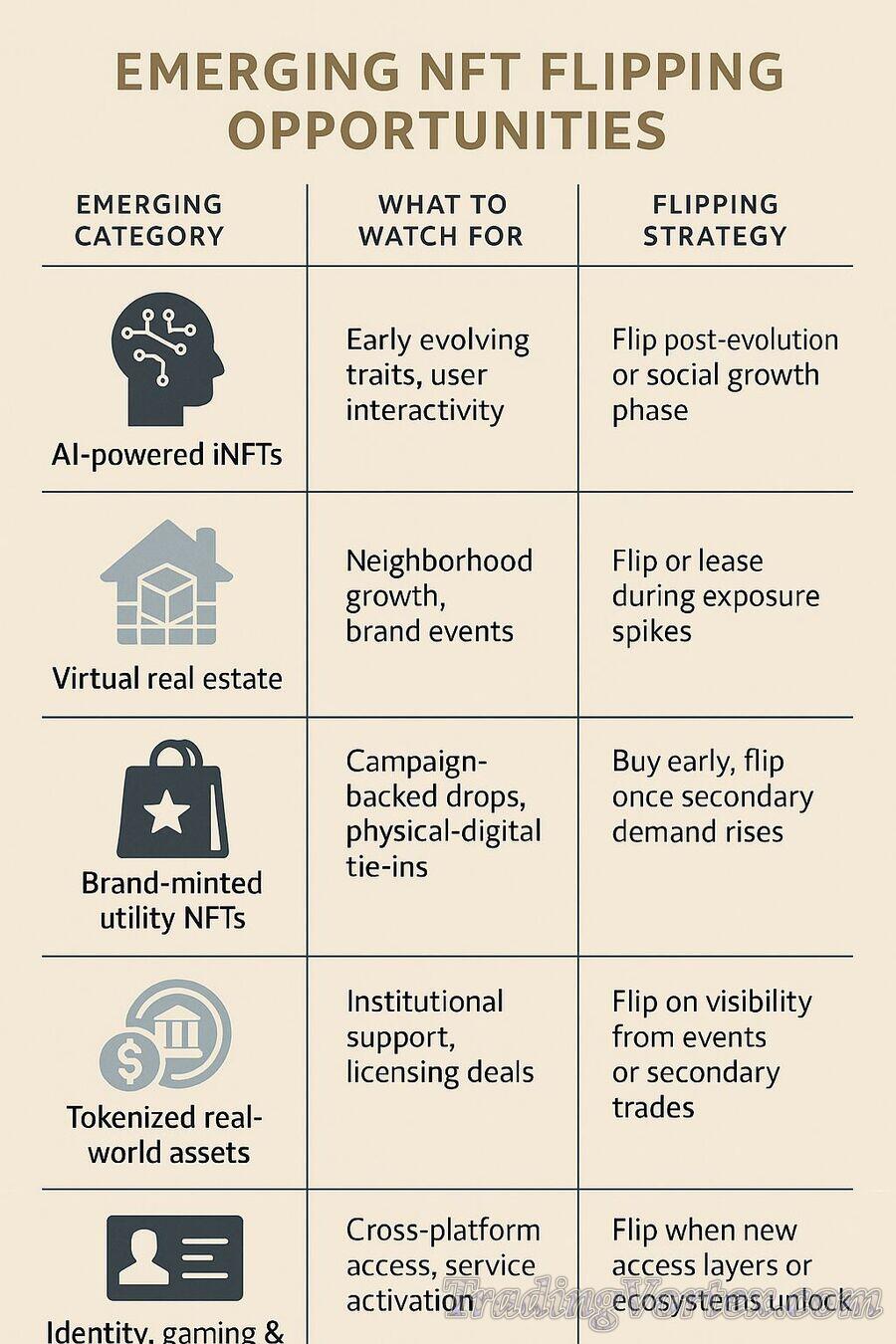
Final Thoughts: How to Flip NFTs Profitably in 2025?
You’ve learned about strategy, risk, success stories and emerging opportunities. Now let’s bring it all together. Flipping NFTs profitably in 2025 is less about luck and more about smart habits, timing and community.
Recap – Top Strategies That Work:
- Buy utility-first NFTs: Projects with staking, membership perks, ID access, or in-game value tend to maintain demand and flip reliably.
- Use fractional ownership and RWA token opportunities: Flip small slices of high-value assets when public interest increases.
- Make NFT-Finance work for you: Stake, lend, or rent NFTs while holding them before flipping at higher prices.
- Leverage cross-chain arbitrage: Buy cheaper on one chain and resell on another where demand or liquidity is higher.
- Time flips using data and community intel: Tools like Nansen, NFTGo, rarity dashboards, plus active Discords and DAO groups, help you anticipate trends before they happen.
Before Your Next Flip – Actionable Checklist:
- Confirm real utility: access, revenue, gaming, identity features
- Diversify across at least two verticals: gaming, access, RWA, art
- Use separate wallets for different NFT strategies to avoid confusion
- Predefine your profit targets and exit plans before entry
- Set up analytics and alerts using tools such as Nansen, Icy.tools, NFTGo and rarity trackers
- Stay plugged into Discords, Twitter/X spaces, DAO communities for alpha hints
- Stake or lend NFTs while holding to earn passive income
- Track royalty rules, tax obligations, and KYC or platform policy updates
- Use tax software or advisors to log cost basis, sale price, and holding duration
Stay Ahead – Monitor Trends, Leverage Tools, Join Communities:
This space evolves fast. Regulation is tightening, Layer‑1 and Layer‑2 chains improve efficiency, and new verticals like identity NFTs, DePIN access, and phygital utility continue growing. Market size projections range from $34 billion to over $60 billion in 2025 and institutional deals are on the rise.
To stay effective:
- Track industry forecasts and reports such as market growth projections, platform activity shifts, and emerging utility use cases
- Let tools automate your monitoring: price alerts, rarity snipes, wallet movement
- Stay active in smart communities where alpha leaks early; influence from insider dialog can beat algorithmic alerts
Final Flip War Story:
When I flipped a membership NFT in early 2025, it wasn’t art hype that pushed the price: it was access to toolkits, gated AMAs, and yield drops. That utility created a steady floor, and flipping after an announcement still left room for profit. That felt more like smart investing than gambling.
Key Takeaways for Smart Flipping:
| Objective | What to Do |
|---|---|
| Maximize consistent returns | Prioritize utility and staking-enabled NFTs |
| Reduce risk exposure | Diversify verticals, wallets and entry points |
| Time trades with confidence | Use analytics, alerts, on-chain data and community intel |
| Protect your gains | Understand fees, taxes, royalties and platform policy |
In 2025, flipping NFTs isn’t a lottery. It's a strategic practice combining utility, diversification, tooling, and community connection. If you apply these principles consistently, you won’t just catch luck: you’ll create it.
Frequently Asked Questions:
Q1. Can you still make money flipping NFTs in 2025?
Absolutely. While overall activity has decreased — total NFT volume dropped around 63 percent year-on-year in early 2025 — smart traders are still finding real profit opportunities. The market has shifted from noise to utility, and flips tied to access, staking, gaming, or revenue streams are outperforming pure speculative collections.
Q2. Which types of NFTs tend to flip reliably?
♦ Utility-first NFTs with built-in staking, access, identity, or gaming features
♦ Blue-chip collectibles like CryptoPunks with proven liquidity and legacy value
♦ Fractionalized real-world assets that allow low entry and scalable upside
♦ Metaverse land tied to upcoming brand activation or virtual events
Each category behaves differently, but when timed and selected wisely, they give more dependability than hype-driven art.
Q3. How do I know I’m not buying into wash-traded volume?
Wash trading still impacts a notable portion of volume: some studies suggest up to 24 percent for specific collections. Signs include multiple trades between the same wallets, repetitive pricing, or low actual community engagement. Use analytics tools to spot these patterns and focus on collections with transparent community activity and real volume.
Q4. What’s the best way to time my flips?
Combine tool-based alerts with community intuition. Platforms like Nansen, Icy.tools, and NFTGo flag wallet accumulation, volume spikes, and rising rarity factors. Pair that with Discord or DAO channels for alpha leaks. This hybrid of data and early access sharpened timing significantly in 2025.
Q5. Are there gas- or fee-related pitfalls I should worry about?
Yes. Flipping on high-fee chains without considering gas or royalties can wipe out profits. Some marketplaces enforce or waive creator royalties, and gas costs vary by network. Consider cross-chain opportunities: buy on a low-cost chain, bridge, then sell on a high-demand network to stretch your margins.
Q6. Do I need to report NFTs for taxes in 2025?
Definitely. NFTs are treated like property in many jurisdictions. That means every sale, even swaps, is potentially taxable. Short-term flips could be taxed as regular income, and certain NFTs like collectibles may face higher rates. Reporting thresholds are now lower, so tracking your cost basis, sale proceeds, and holding periods is essential.
Q7. What tools help me get good, fast?
♦ Nansen for wallet and whale tracking
♦ Icy.tools for mint drops, volume spikes, and alerting
♦ NFTGo for AI-powered collection insights and trend tracking
♦ Rarity.tools or TraitSniper for focusing on rare traits
♦ Alert bots like Moby, Ninja Alerts, or Floor for instant signals
Use them to build personal dashboards that align with your flip strategy.
Q8. Should I join NFT communities or groups?
Yes. The best flips often start in Discord servers, DAO chats, or Twitter Spaces. That’s where early announcements happen and alpha leaks before being computationally visible. Being active in real communities gives you timing and access that tools can’t replace.
Q9. How do I manage flipping risk like a professional?
♦ Use separate wallets for speculation, utility assets, and long-term holds
♦ Set clear profit targets and define exit rules before you buy
♦ Safeguard your seed phrase and enable 2FA
♦ Validate smart contracts before minting or interacting
♦ Keep tax software updated and maintain records for every trade
Treat flipping like a small business: disciplined, structured, and always protected.
Final Thought: Flipping NFTs in 2025 is still profitable for those who treat it like craft, not chaos. Focus on utility, monitor tools, engage your communities, manage risk, and flip with strategy.





















